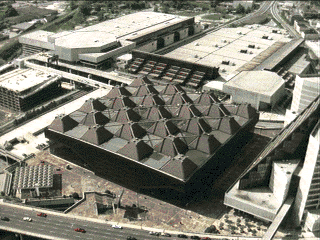Omni Coliseum
Omni Coliseum (often called The Omni) was an indoor arena in Atlanta, Georgia, United States. Completed in 1972, the arena seated 16,378 for basketball and 15,278 for hockey. It was part of the Omni Complex, now known as the CNN Center.
"The Omni" | |
 The Omni in 1979 | |

| |
| Location | 100 Techwood Drive Atlanta, Georgia 30303 United States |
|---|---|
| Coordinates | 33°45′27″N 84°23′48″W |
| Owner | City of Atlanta |
| Operator | City of Atlanta |
| Capacity | Basketball: 16,181 (1972–1977), 16,400 (1977–1984), 16,522 (1984–1987), 16,451 (1987–1988), 16,371 (1988–1990), 16,390 (1990–1991), 16,425 (1991–1992), 16,441 (1992–1993), 16,368 (1993–1994), 16,378 (1994–1997) Hockey: 15,078 (1972–1973), 15,141 (1973–1977), 15,155 (1977–1983), 15,278 (1984–1997) |
| Construction | |
| Broke ground | March 30, 1971[1] |
| Opened | October 14, 1972 |
| Closed | May 11, 1997 |
| Demolished | July 26, 1997 |
| Construction cost | $17 million ($104 million in 2019 dollars[2]) |
| Architect | Thompson, Ventulett, Stainback & Associates |
| Structural engineer | Prybylowski and Gravino, Inc.[3] |
| Services engineer | Lazensky & Borum, Inc.[4] |
| General contractor | Ira H. Hardin Company[3] |
| Tenants | |
| Atlanta Hawks (NBA) (1972–1997) Atlanta Flames (NHL) (1972–1980) Atlanta Chiefs (NASL Indoor) (1979–1981) Atlanta Attack (AISA/NPSL) (1989–1991) Atlanta Knights (IHL) (1992–1996) Atlanta Fire Ants (RHI) (1994) | |
It was the home arena for the Atlanta Hawks of the National Basketball Association from 1972 until the arena's closure in 1997 and the Atlanta Flames of the National Hockey League from their inception in 1972 until 1980, when the franchise was sold and relocated to Calgary, Alberta. It also hosted the 1977 NCAA Men's Division I Basketball Tournament, the 1988 Democratic National Convention, and the 1996 Summer Olympics indoor volleyball competition.
The Omni was closed and demolished in 1997. Its successor, State Farm Arena, was constructed on the Omni's site and opened in 1999.
History
The arena was considered an architectural marvel that combined innovative roof, seating, and structural designs. The logo is based on the unique seating arrangement. The exterior cladding was composed of Cor-Ten weathering steel, which is covered in rust; the idea was that the steel would continue to rust to the point where the rusted exterior would form a protective seal, making a solid steel structure that would last for decades. The Omni was noted for its distinctive space frame roof, often joked about as looking like an egg crate or a rusty waffle iron. Designed by the firm of tvsdesign with structural engineering work by the firm of Prybylowski and Gravino, the roof was technically described as an ortho-quad truss system.
Scoreboard
The only surviving component of the Omni is its scoreboard, which now hangs in the pavilion of the State Farm Arena. American Sign and Indicator (which became Trans-Lux) built the basketball-specific scoreboard in the early 1980s to replace the original hockey-specific scoreboard that Daktronics maintained during the 1990s. The arena also had four message boards in each end zone, two of which were animation boards.
Events
Professional wrestling
The Omni was a hotbed for professional wrestling. It was considered the home base for the NWA's Georgia Championship Wrestling since its opening, Jim Crockett Promotions in the late 1980s, and WCW. Many major and historic wrestling events took place at the Omni, including Starrcades in 1985, 1986, 1989 and 1992, the first WarGames match during the Great American Bash tour in 1987, and the first Slamboree in 1993. The World Wrestling Federation also held many shows at the Omni.
Basketball and hockey
The Omni was home to the NBA Atlanta Hawks from 1972 to 1997; their final game at the Omni was during the 1997 NBA Playoffs Eastern Conference Semifinals against the Chicago Bulls (Game 4) on May 11, 1997; they lost 89–80. The Omni was also home of the NHL Atlanta Flames from 1972 to 1980 (now the Calgary Flames), and the IHL Atlanta Knights (1992–1996). In 1994, the Knights became the only pro team to win a championship in the building when they won the Turner Cup.
The arena also hosted the 1977 NCAA Final Four, won by Marquette University over North Carolina in what was Warriors' (their nickname at the time, now known as the Golden Eagles) coach Al McGuire's last game, one SEC and three ACC men's basketball tournaments, the 1978 NBA All-Star Game, the 1993 NCAA Women's Basketball Final Four, and the indoor volleyball matches for the 1996 Summer Olympics.
Indoor soccer
The Omni was the indoor home of the Atlanta Chiefs of the North American Soccer League as well as the Atlanta Attack of the American Indoor Soccer Association.
Concerts
The Omni was Atlanta's primary concert venue from 1972 to 1997.
Other events
Among the major non-sports events at the Omni was the 1988 Democratic National Convention where delegates nominated Michael Dukakis and Lloyd Bentsen for President and Vice President of the United States, respectively.
Problems

The Omni did not last nearly as long as many other arenas built during the same time period, in part because a number of its innovations did not work as intended. The most serious problem was the weathered steel exterior, which could not withstand Atlanta's humid climate. Rather than provide a protective seal, it never stopped rusting. Indeed, it corroded much faster than was anticipated, eventually resulted in gaping holes forming in the walls that fans could climb through. Chain link fences were installed to keep people from crawling through the wall to see events. Partly due to this, the structure had begun to look dated by the early 1990s (although the arena was only 20 years old).
Built on a former railroad yard, it settled more than its designers expected after construction. There were unanticipated stresses in the space frame roof, which often leaked water.
In the late 1980s and early 1990s, a growing number of NBA and NHL teams began to construct arenas with better amenities for their high-end customers to increase revenue. These amenities included luxury boxes, club seating, and massive club concourses. Some of these new arenas had as many as 200 luxury boxes. By comparison, the Omni had only 16 luxury boxes and no club level. It also became a disadvantage during Atlanta's explosive population growth. Until the now-defunct Georgia Dome was finished in 1992, the Omni was Atlanta's largest indoor facility in terms of seating capacity, meaning other smaller venues in the region often hosted other sporting and musical events that would usually be hosted in an arena setting.
Although the Omni hosted many events, it lost more than its share due to the smaller capacity and lack of amenities compared to newer buildings in other cities. By the start of the 1990s, an effort began to build a replacement. A new arena would have likely been needed in any event due to the Omni's structural problems. This also stemmed from Ted Turner's desire to own an NHL franchise; the Flames had been sold to Canadian businessmen and relocated to Calgary, Alberta a decade earlier. The NHL determined the Omni was not suitable even as a temporary facility, and would only grant Atlanta an expansion team if Turner guaranteed a brand-new arena would be in place by the time the new team took the ice. On July 26, 1997, the Omni was demolished by implosion despite the arena's close proximity to CNN Center, the Georgia World Congress Center, and the Omni MARTA station. Philips Arena, now State Farm Arena, which was constructed on the site, opened on September 18, 1999. The demolition of the Omni forced the Hawks to split the 1997–98 and 1998–99 seasons between Alexander Memorial Coliseum at Georgia Tech, their first home in Atlanta, and the Georgia Dome.
References
- "Georgia News Briefs". Rome News-Tribune. March 30, 1971. Retrieved March 28, 2012.
- Federal Reserve Bank of Minneapolis. "Consumer Price Index (estimate) 1800–". Retrieved January 1, 2020.
- "Archived copy" (PDF). Archived from the original (PDF) on 2012-05-14. Retrieved 2012-05-21.CS1 maint: archived copy as title (link)
- "A Great Space". Engineering News-Record. McGraw-Hill Companies. 189 (2): 12.
External links
| Wikimedia Commons has media related to Omni Coliseum. |
- 1996 Summer Olympics official report. Volume 1. p. 543.
- 1996 Summer Olympics official report. Volume 3. p. 465.
| Events and tenants | ||
|---|---|---|
| Preceded by Alexander Memorial Coliseum |
Home of the Atlanta Hawks 1972 – 1997 |
Succeeded by Georgia Dome & Alexander Memorial Coliseum |
| Preceded by first arena |
Home of the Atlanta Flames 1972 – 1980 |
Succeeded by Stampede Corral |
| Preceded by The Spectrum |
NCAA Men's Division I Basketball Tournament Finals Venue 1977 |
Succeeded by The Checkerdome |
| Preceded by MECCA Arena |
Host of the NBA All-Star Game 1978 |
Succeeded by Pontiac Silverdome |
_pictogram.svg.png.webp)